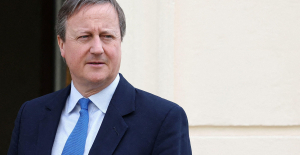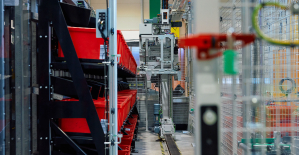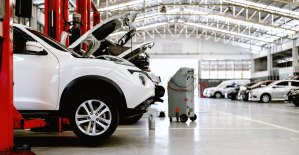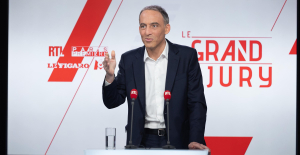With the railway bridges in Hasselbrook, Amina Karam did it very differently than you would normally do. Because "usual" would take too long when building the new S-Bahn line S4, which is to connect Hamburg with Bad Oldesloe. At the end of 2022, a bridge for new bypass tracks had to be laid over the lowered Hammer Straße in order to speed up the construction of the S4. A concrete bridge, which should actually be built there, was not yet available at that time. Karam, 39, project manager for the S4, instead ordered two steel bridge segments from Deutsche Bahn's inventory and had them installed.
In a few years, the provisional arrangements will then be exchanged for a concrete structure – but Deutsche Bahn and its partner companies will initially gain time during the course of the large-scale project. Up to 13 months, says Karam during a tour of the construction site: "You have to have the courage to break new ground and revise planned processes if better solutions become possible."
Germany's transport routes are at the limit, the federal and state governments are investing billions in roads, rails and watercourses. For a long time, the German infrastructure was considered one of the best in the world. But in recent years, public projects have become more and more synonymous with the horror of construction: sometimes citizens' initiatives prevent a rail project that has already been largely planned, such as the "Y-Trasse" long-distance freight railway between Bremen, Hamburg and Hanover, sometimes an entire section of the motorway collapses as happened on the relatively young A20 in Mecklenburg-Western Pomerania, sometimes it takes 20 years from the first planning to the realization of the Elbe deepening.
The traffic light coalition in Berlin wants to take comprehensive countermeasures in order to bring the German transport system to the necessary and desired level. A central building block is the strengthening of rail transport and the introduction of a close-meshed "Germany cycle" by the end of the decade. This corresponds directly to the "traffic turnaround" in Hamburg and the expansion of local rail transport in the second largest German city and its metropolitan region.
By the end of 2029, Deutsche Bahn wants to partially rebuild the route for the S4 with a daily capacity of up to 250,000 passengers and thus relieve regional and long-distance traffic in the north-east of Hamburg in the future. In the northwest, the S21 will be expanded to the S5 between Eidelstedt and Kaltenkirchen in the coming years.
The municipal elevated railway, in turn, built the new U5 line by the 2030s, which is intended to connect the east of Hamburg in a wide arc through the city center with the stadiums in the west. The existing U4 line will be extended to the Horner Geest in the east of Hamburg by 2026 and, in the long term, possibly continue south beyond the Elbe bridges to Wilhelmsburg.
Last year, Federal Transport Minister Volker Wissing (FDP) set up a commission to accelerate and optimize rail expansion so that the federal government can get its workload under control. In their final report from December 2022, the experts named, among other things, ten pilot projects across Germany for the so-called "rail partnership model" - one of which is the construction of the S4 in Hamburg.
To put it simply, it is about the complete integration of all those involved in construction, about modern forms of tenders, the optimization of processes and a better distribution of risks. "We work as flexibly as possible and are constantly testing new technological and logistical options," says Project Manager Karam. "This concept of so-called 'agile construction' helps us a lot, especially here in the cramped conditions within the city."
Ideas for acceleration are in demand. "Here in Wandsbek, probably from May, we will use overhead line masts with the help of helicopters instead of assembling them from the ground," says Karam between excavation and heavy-duty vehicles. “This procedure, with its high security requirements, is by no means common within a city. But it will save us a lot of time, especially within the city.”
With the provisional steel bridges in Hasselbrook, Deutsche Bahn wants to reduce the number and duration of the so-called "closing periods" during which regular train traffic is restricted due to construction work. From the point of view of Hamburg Transport Senator Anjes Tjarks (Greens), the S4 is indispensable for the modernization of Hamburg's local transport system as a whole and also for relieving the burden on the main station: "By lifting two existing bridges and through 'agile construction', Deutsche Bahn is ensuring this that the regional traffic to Lübeck can continue to roll during the work on the S4 route and that the project is on schedule."
Inflation, a shortage of skilled workers and faltering supply chains make public construction projects more complicated than they already are. In the traditional logic, this leads to friction, blame and deadlock between public clients and private companies. Deutsche Bahn wants to minimize such effects with its new model. "There are no classic 'clients' and 'contractors' with the S4 - everyone involved is a project partner," says Karam. “All building companies, for example, are involved in the planning process right from the start. All those involved agree on common goals and are then jointly responsible for possible additional costs. However, I am responsible for the coordination and management of the overall project.”
Hochbahn takes a similar approach to its major projects: "We always rely on partnership in construction and fair dealings between client and contractor," says a spokeswoman for the subsidiary Hochbahn U5 Projekt GmbH, which is realizing the new line. This includes scheduling, construction progress, the distribution of risks and the development of innovations through the principle of "value engineering".
Karam says the S4 project, which costs around 1.85 billion euros, is "right on schedule". The first planning approval section, which has been under construction since 2021, should be completed by the end of 2027. For the second section, your project team recently forwarded the planning approval documents to the responsible Hamburg transport authority. After the detailed examination, it will be made public in the coming weeks so that citizens and associations can comment. This procedure will also follow in the summer for the third planning section.
Communication with the public, says the native Moroccan about her experiences in Germany, is as important as the cohesion within the project. Her team works closely with the city and with the local citizens, for example on the question of how to find the best noise protection along the route: “In this country, citizens rightly demand a lot of transparency and participation. That's good, and you always have to take that into account - we can't and don't want to build against people, we want to build for them."
Moroccan-born Amina Karam, 39, studied civil engineering in Cologne after graduating from high school. At the age of 28, she was the technical director of the metro in the Algerian capital Algiers. In Port Said, Egypt, she led the construction of a road tunnel under the Suez Canal. Karam has been leading the project team for the construction of the new S-Bahn line S4 at Deutsche Bahn in Hamburg since February 2021.

 Iran-Israel: David Cameron wants the G7 to impose “coordinated sanctions” on Iran
Iran-Israel: David Cameron wants the G7 to impose “coordinated sanctions” on Iran Donald Trump trial: who is Stormy Daniels, the ex-porn star who makes the former American president tremble?
Donald Trump trial: who is Stormy Daniels, the ex-porn star who makes the former American president tremble? The day after their conference in Brussels was banned, the nationalist right won their case
The day after their conference in Brussels was banned, the nationalist right won their case Summoning the Iranian ambassador: how the dissemination of “fake news” forced Stéphane Séjourné to react
Summoning the Iranian ambassador: how the dissemination of “fake news” forced Stéphane Séjourné to react New generation mosquito nets prove much more effective against malaria
New generation mosquito nets prove much more effective against malaria Covid-19: everything you need to know about the new vaccination campaign which is starting
Covid-19: everything you need to know about the new vaccination campaign which is starting The best laptops of the moment boast artificial intelligence
The best laptops of the moment boast artificial intelligence Amazon invests 700 million in robotizing its warehouses in Europe
Amazon invests 700 million in robotizing its warehouses in Europe Planned obsolescence: an association warns of the risk of seeing the development of “disposable cars”
Planned obsolescence: an association warns of the risk of seeing the development of “disposable cars” In the private sector, 42% of employees took sick leave last year
In the private sector, 42% of employees took sick leave last year Growth, savings, inflation... These very optimistic forecasts from the government which worry the Court of Auditors
Growth, savings, inflation... These very optimistic forecasts from the government which worry the Court of Auditors In the United States, Google employees demonstrate to demand the repeal of a cloud contract with Israel
In the United States, Google employees demonstrate to demand the repeal of a cloud contract with Israel Gaby, a new play by Pagnol adapted into a comic strip
Gaby, a new play by Pagnol adapted into a comic strip British Taylor Swift fans lose hundreds of euros in counterfeit notes
British Taylor Swift fans lose hundreds of euros in counterfeit notes Celine Dion promises a “raw and honest” film about her illness and her life as an artist
Celine Dion promises a “raw and honest” film about her illness and her life as an artist New York Philharmonic Orchestra Continues Concert Despite Earthquake Warnings
New York Philharmonic Orchestra Continues Concert Despite Earthquake Warnings Skoda Kodiaq 2024: a 'beast' plug-in hybrid SUV
Skoda Kodiaq 2024: a 'beast' plug-in hybrid SUV Tesla launches a new Model Y with 600 km of autonomy at a "more accessible price"
Tesla launches a new Model Y with 600 km of autonomy at a "more accessible price" The 10 best-selling cars in March 2024 in Spain: sales fall due to Easter
The 10 best-selling cars in March 2024 in Spain: sales fall due to Easter A private jet company buys more than 100 flying cars
A private jet company buys more than 100 flying cars This is how housing prices have changed in Spain in the last decade
This is how housing prices have changed in Spain in the last decade The home mortgage firm drops 10% in January and interest soars to 3.46%
The home mortgage firm drops 10% in January and interest soars to 3.46% The jewel of the Rocío de Nagüeles urbanization: a dream villa in Marbella
The jewel of the Rocío de Nagüeles urbanization: a dream villa in Marbella Rental prices grow by 7.3% in February: where does it go up and where does it go down?
Rental prices grow by 7.3% in February: where does it go up and where does it go down? Europeans: the schedule of debates to follow between now and June 9
Europeans: the schedule of debates to follow between now and June 9 Europeans: “In France, there is a left and there is a right,” assures Bellamy
Europeans: “In France, there is a left and there is a right,” assures Bellamy During the night of the economy, the right points out the budgetary flaws of the macronie
During the night of the economy, the right points out the budgetary flaws of the macronie Europeans: Glucksmann denounces “Emmanuel Macron’s failure” in the face of Bardella’s success
Europeans: Glucksmann denounces “Emmanuel Macron’s failure” in the face of Bardella’s success These French cities that will boycott the World Cup in Qatar
These French cities that will boycott the World Cup in Qatar Barça-PSG: legendary match, the Parisian mentality, Donnarumma not serene… Favorites and scratches
Barça-PSG: legendary match, the Parisian mentality, Donnarumma not serene… Favorites and scratches Basketball: Poupet, the Villeurbanne coach, extends
Basketball: Poupet, the Villeurbanne coach, extends Barça-PSG: “Mbappé super”, the European press is delighted with the Frenchman’s return to the forefront
Barça-PSG: “Mbappé super”, the European press is delighted with the Frenchman’s return to the forefront Rugby: Antoine Dupont provides support to a young player seriously injured and plunged into an artificial coma
Rugby: Antoine Dupont provides support to a young player seriously injured and plunged into an artificial coma


















